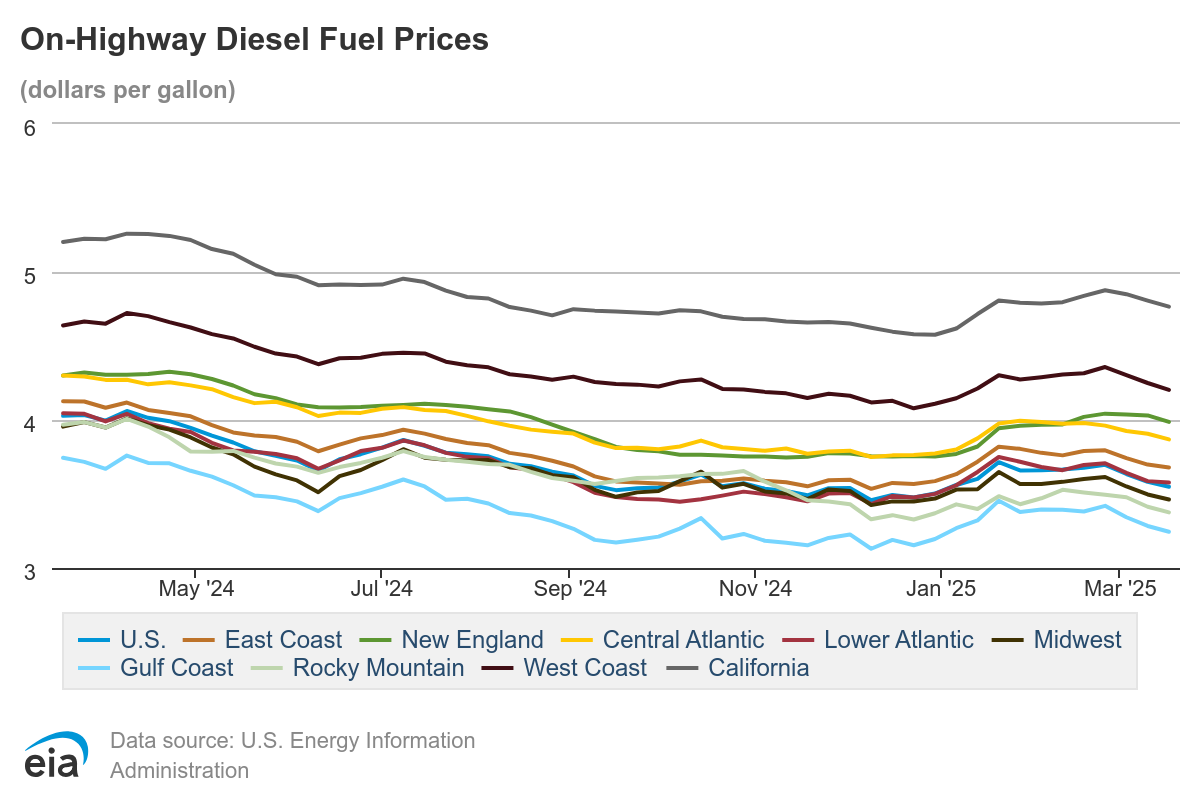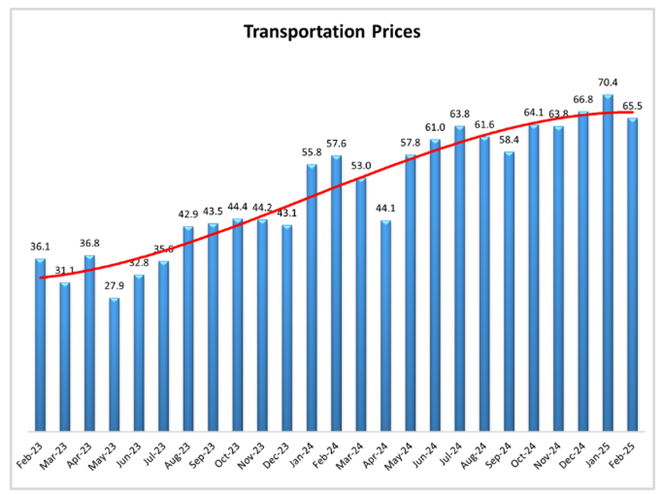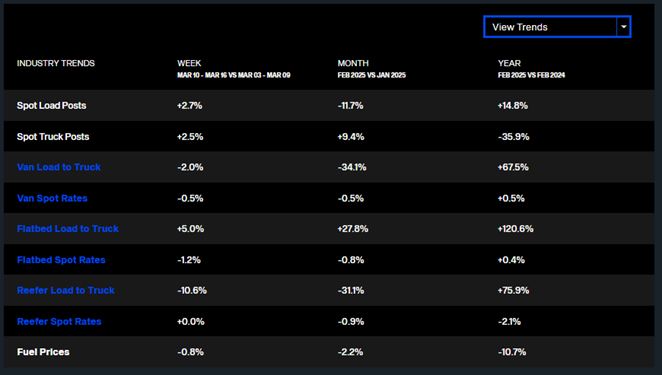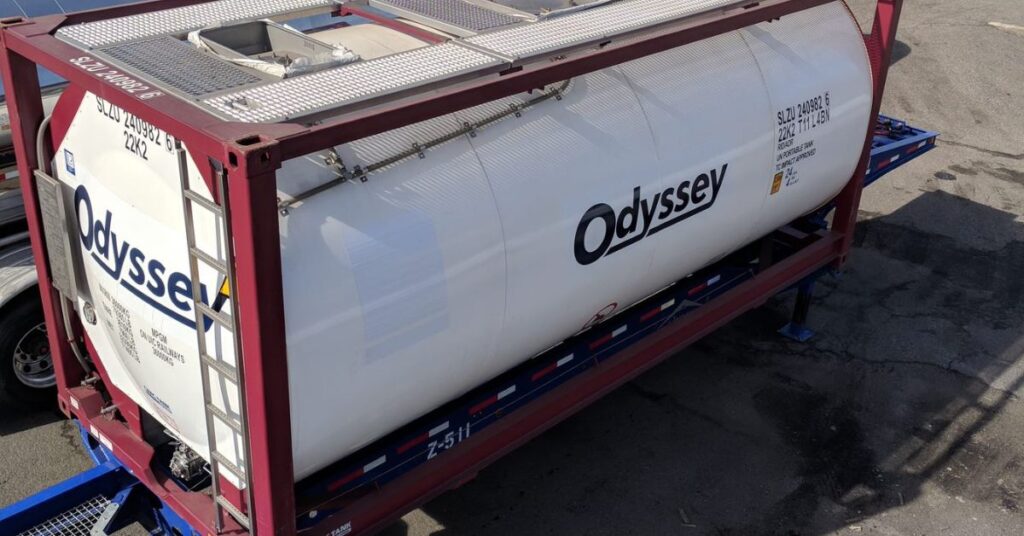Contents:
Key Odyssey Network Indicators

Shipper Actions
In today’s competitive environment, becoming a preferred shipper to carriers can help improve attaining sufficient capacity. Things that shippers offer that help reach this status can include:
Accuracy:
Forecast for the end of month/end of quarter – plan for surges in your needs to ensure coverage
Develop order lead time – at least 5 days in advance. ask carriers for “best case” options
Specificity:
Request delivery windows from customers…often 8 a.m. deliveries are requested when product really is not need until much later. A window of 8-10 a.m. may have a better chance of coverage.
Spread delivery times across the day
Assess what your customers really need. Make sure that customer delivery requirements are up to date and accurate. Do not require equipment/assessorials that are not needed
Flexibility:
- Offer flexible load times
- Explore/ be open to mode options including intermodal
Driver-friendliness:
- Load/unload within the normal 2 hours-time is money to drivers
- Provide creature comforts (clean restrooms, rest areas, free Wi-Fi, a cup of coffee, etc.)
Consistency:
- Offer consistent volume that carriers can plan against
- Reduce order changes – a new date may put coverage at risk
Efficiency:
- Maximize payload on trucks
- Utilize trailer drop yards at high volume origins when possible
- Prioritize loading/unloading trucks quickly at facilities
Promptness:
- Pay carriers within their contracted freight terms- cash flow is vital to carriers
Economic Update
GDP Change

Gross Domestic Product | U.S. Bureau of Economic Analysis (BEA)
- Real gross domestic product (GDP) increased at an annual rate of 2.3 percent in the fourth quarter of 2024, according to the advance estimate released by the U.S. Bureau of Economic Analysis. In the third quarter, real GDP increased 3.1 percent.
- The GDP increase in real GDP in the fourth quarter primarily reflected increases in consumer spending and government spending that were partly offset by a decrease in investments.
- Imports, which are a subtraction in the calculation of GDP, decreased.
Unemployment

https://www.bls.gov/charts/employment-situation/civilian-unemployment-rate.htm
- Total nonfarm payroll employment rose by 151,000 in February, and the unemployment rate changed little at 4.1 percent, the U.S. Bureau of Labor Statistics reported Friday, March 7, 2025.
- Job gains occurred in health care, financial activities, transportation and warehousing, and social assistance, while federal government employment declined.
- This news release presents statistics from two monthly surveys.
- The household survey measures labor force status, including unemployment, by demographic characteristics.
- The establishment survey measures non-farm employment, hours, and earnings by industry.
Household Survey Data
- The unemployment rate, at 4.1 percent, and the number of unemployed people, at 7.1 million, changed little in February.
- The unemployment rate has remained in a narrow range of 4.0 percent to 4.2 percent since May 2024.
- The number of long-term unemployed (those jobless for 27 weeks or more), at 1.5 million, changed little in February. The long-term unemployed accounted for 20.9 percent of all unemployed people.
- The employment-population ratio decreased by 0.2 percentage points to 59.9 percent in February but showed little change from a year earlier.
- The labor force participation rate, at 62.4 percent, changed little over the month and over the year.
- The number of people employed part time for economic reasons increased by 460,000 to 4.9 million in February. These individuals would have preferred full-time employment but were working part-time because their hours had been reduced, or they were unable to find full-time jobs.
Establishment Survey Data
- Total nonfarm payroll employment rose by 151,000 in February, similar to the average monthly gain of 168,000 over the prior 12 months. In February, employment trended up in health care, financial activities, transportation and warehousing, and social assistance.
- Transportation and warehousing employment continued to trend in February (+18,000), in line with the average monthly gain over the prior 12 months (+13,000). Over the month, job growth occurred in couriers and messengers (+24,000) and air transportation (+4,000).
- Within government, federal government employment declined by 10,000 in February.
- Employment in retail trade changed little over the month (6,000) and has shown little net change over the year. In February, employment in food and beverage retailers declined by 15,000, largely due to strike activity. Warehouse clubs, supercenters, and other general merchandise retailers added 10,000 jobs.
- Employment showed little change over the month in other major industries, including mining, quarrying, and oil and gas extraction; construction; manufacturing; wholesale trade; information; professional and business services; leisure and hospitality; and other services.
- In February, average hourly earnings for all employees on private nonfarm payrolls rose by 10 cents, or 0.3 percent, to $35.93. Over the past 12 months, average hourly earnings have increased by 4.0 percent. In February, average hourly earnings of private-sector production and nonsupervisory employees rose by 9 cents, or 0.3 percent, to $30.89.
U.S. Truck Transportation Employment

All Employees, Truck Transportation (CEU4348400001) | FRED | St. Louis Fed
Truck employment declined in February
- At 1.494M in February compared to 1.500M in January, on a non-seasonally adjusted basis
- And slightly below the 1.504M persons employed in February 2024
Manufactured Goods – New Orders

https://www.census.gov/manufacturing/m3/current/index.html
Monthly Full Report on Manufacturers’ Shipments, Inventories, & Orders
(Released March 5, 2025)
- New orders for manufactured goods in January, up following two consecutive monthly decreases, increased $9.8 billion or 1.7 percent to $589.9 billion, the U.S. Census Bureau reported today. This followed a 0.6 percent December decrease.
- Shipments, up for three consecutive months, increased $2.4 billion or 0.4 percent to $592.1 billion. This followed a 0.6 percent December increase.
- Unfilled orders, up six of the last seven months, increased $2.7 billion or 0.2 percent to $1,400.6 billion. This followed a 0.3 percent December decrease.
- The unfilled orders-to-shipments ratio was 6.85, down from 6.93 in December. Inventories, up three consecutive months, increased $0.8 billion or 0.1 percent to $863.7 billion. This followed a 0.3 percent December increase.
- The inventories-to-shipments ratio was 1.46, unchanged from December.
Transportation Update
Fuel

https://www.eia.gov/petroleum/gasdiesel/?os=frefapp
The national average price of diesel for the week of March 3 stood at $3.64 per gallon, an increase of 3 cents from four weeks prior at the end of January and down $0.479 from a year ago.
Transportation Capacity

February 2025 Logistics Managers’ Index – LOGISTICS MANAGERS’ INDEX
- The Transportation Capacity Index moved up to 55.1 in February 2025. This constitutes an increase of 2.5 points from last month’s reading. As such, the upward movement of the Transportation Capacity index seems to have resumed, reaching the highest point recorded over the past six months.
- There is no significant difference between Upstream and Downstream, with Upstream Transportation Capacity index at 53.0 and the Downstream index at 59.0. As such, the slight expansion trend in Transportation Capacity remains present both Upstream and Downstream, across the supply chains.
- The future Transportation Capacity index is now at 51.9, indicating expectations of a slightly increasing Transportation Capacity over the next 12 months.
Transportation Prices

February 2025 Logistics Managers’ Index – LOGISTICS MANAGERS’ INDEX
- The Transportation Prices Index came back down to 65.5 in February 2025, which corresponds to a decrease of 4.9 points from the previous month, retreating from recent highs.
- The future index for Transportation Prices also retreats to 76.8, however it is still indicating strong expectations of higher Transportation Prices in the next 12 months.
Cass Freight & Truckload Index
Uncertainty Reigns

Source: Cass Information Systems, Inc.
Cass Transportation Index Report | February 2025 | Cass Information Systems

Source: Cass Information Systems, Inc.
Cass Transportation Index Report | February 2025 | Cass Information Systems
The Cass Truckload Linehaul Index is a measure of market fluctuations in per-mile truckload linehaul rates, independent of additional cost components such as fuel and accessorials.
The Cass Truckload Linehaul Index rose 1.2% m/m in February, the sixth straight small increase from a cycle low in August.
- The index was 4.8% above that August low in February.
- The year-over-year change accelerated to a 1.9% increase in February after a 0.8% increase in January.
- This index fell 10% in 2023 and another 3% in 2024.
Truck Tonnage Index

ATA: Truck tonnage surges 3% in February | Bulk Transporter
ATA: Truck tonnage surges 3% in February
From the American Trucking Associations (ATA) on Mar 19, 2025:
- Trucking activity in the United States surged 3% in February, marking the largest sequential increase in several years, according to American Trucking Associations’ advanced seasonally adjusted For-Hire Truck Tonnage Index.
- February’s gains followed a slight decline in January, ATA added.
- “After a scant 0.1% decline in January, which wasn’t bad considering the harsh winter weather and California wildfires, truck tonnage had a robust gain in February,” Bob Costello, ATA chief economist, said in a news release. “This outcome fits well with our growing optimism for the truck freight market after a two-year recession. Some of the gain in February was due to accelerated imports early in the year as shippers rushed to bring products into the U.S. before tariffs hit.
- “Even accounting for this, the first two months of the year were positive, all things considered, indicating that the freight recovery has indeed begun.”
- In February, the Truck Tonnage Index equaled 115.2, up from 111.9 in January. The index, which is based on 2015 as 100, was up 0.6% from the same month last year, the second straight year-over-year increase, which hasn’t happened since early 2023.
National Spot Rates

Source: DAT Analytics | https://www.dat.com/trendlines
The chart above depicts national average rates (including fuel surcharges) in the past 13 months, derived from DAT RateView.












